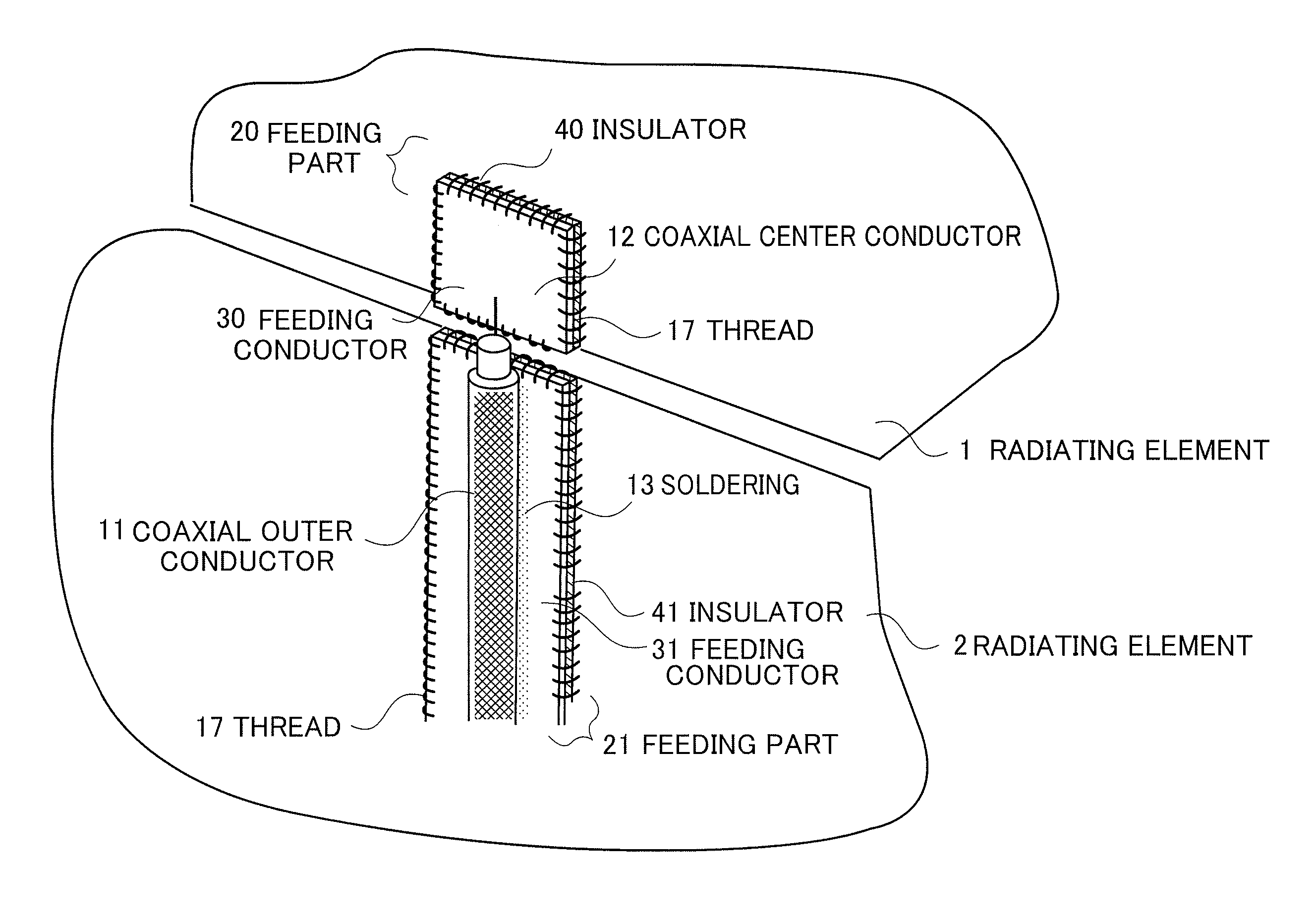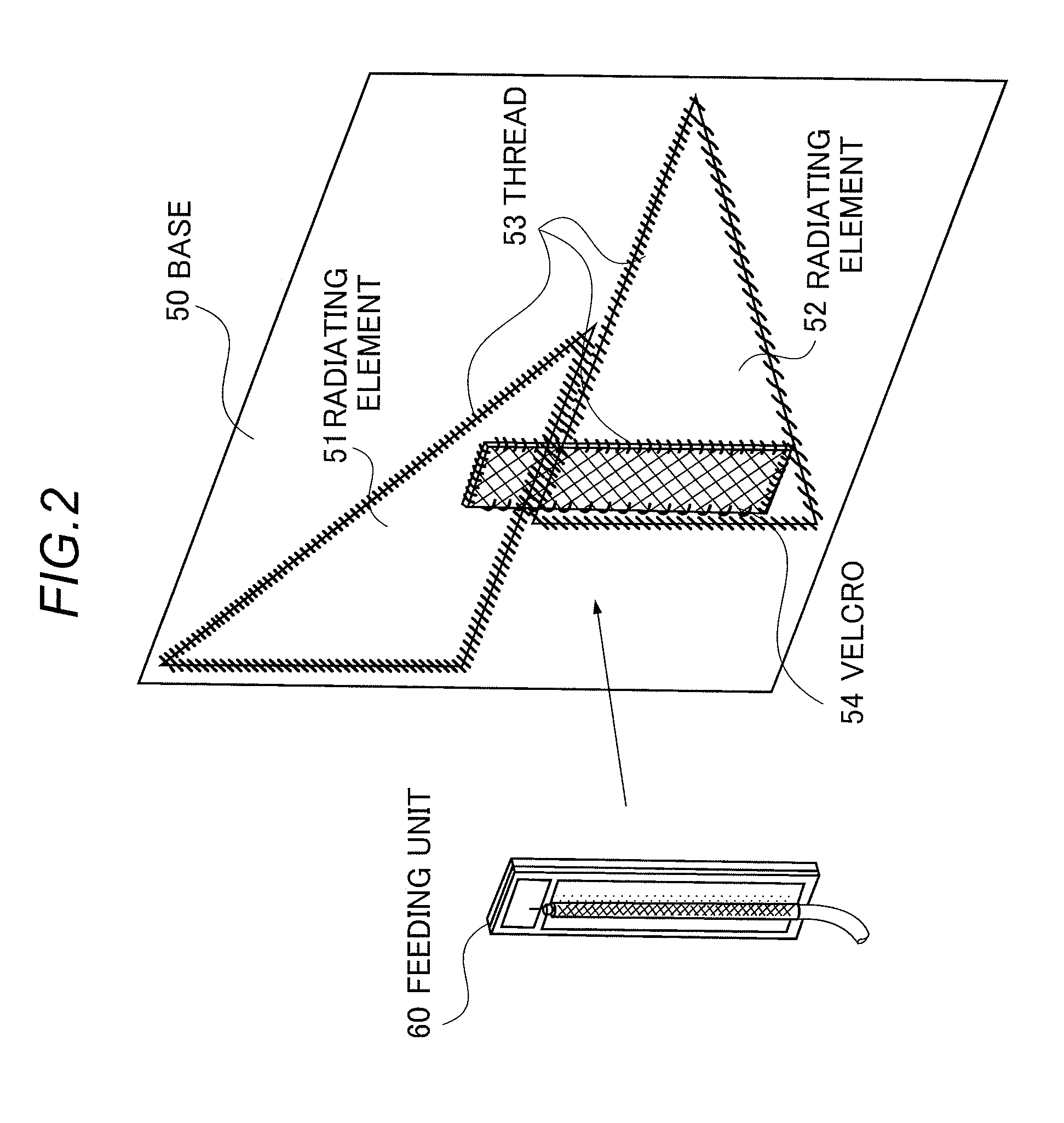Feed device
- Summary
- Abstract
- Description
- Claims
- Application Information
AI Technical Summary
Benefits of technology
Problems solved by technology
Method used
Image
Examples
first embodiment
[0036]FIG. 1 is a configuration diagram of the feeding apparatus according to the present invention. Radiating elements 1 and 2 of arbitrary shape are made of a flexible printed circuit board, conductive cloth, or the like that is flexible. A feeding part 20 includes a feeding conductor 30 and an insulator 40. Typically, the feeding part 20 is integrally made of a flexible printed circuit board or thin printed circuit board. A feeding part 21 similarly includes a feeding conductor 31 and an insulator 41. Like the feeding part 20, the feeding part 21 is integrally made of a flexible printed circuit board or thin printed circuit board. The feeding parts 20 and 21 are sewn on and fixed to the radiating elements 1 and 2 with a thread 17, respectively.
[0037]The thread 17 may be an ordinary non-conductive thread, a conductive thread, or a conductive wire.
[0038]A coaxial center conductor 12 is soldered to the feeding conductor 30, and a coaxial outer conductor 11 is soldered to the feeding...
second embodiment
[0040]FIG. 2 is a configuration diagram of the feeding apparatus according to the present invention. A base 50 is made of soft flexible material such as cloth. Radiating elements 51 and 52 of arbitrary shape are made of conductor cloth, a flexible printed circuit board, or the like that is flexible, and are sewn on the base 50 with a thread 53. A Velcro™54 is sewn on near the intended feeding positions of the radiating elements 51 and 52 with the thread 53. Note that the radiating elements 51 and 52, and the Velcro™54 may be bonded with an adhesive or with the adhesive of a heat transfer sheet instead of the thread 53. A feeding unit 60 is configured to be attached to the Velcro™54 for feeding.
[0041]FIG. 3 is a detailed view of the feeding unit 60. The feeding unit 60 includes a Velcro™61 and a printed circuit board 62. The Velcro™61 is intended to join the feeding unit 60 to the Velcro™54 on the radiating-element side in FIG. 2. The printed circuit board 62 is made of a flexible pr...
third embodiment
[0042]FIG. 4 is a configuration diagram of the feeding apparatus according to the present invention. As in FIG. 2, a base 50 is made of soft flexible material such as cloth. Radiating elements 51 and 52 of arbitrary shape are sewn on the base 50 with a thread 53. A hook 70 is sewn on the intended feeding position of the radiating element 51 with a thread. A Velcro™71 is sewn on near the intended feeding position of the radiating element 52 with the thread 53. Again, the Velcro™71 may be fixed with an adhesive or the like instead of the thread 53 as mentioned previously.
[0043]A feeding unit 80 includes a hook 81 and a Velcro™82, which can be attached to the hook 70 and the Velcro™71, respectively, so that the feeding unit 80 is in close contact with the base 50 to feed the radiating elements 51 and 52.
[0044]FIG. 5 is a detailed view of the feeding unit 80. The feeding unit 80 has two possible configurations (1) and (2).
[0045]In the configuration (1), the feeding unit 80 includes a me...
PUM
 Login to View More
Login to View More Abstract
Description
Claims
Application Information
 Login to View More
Login to View More - R&D
- Intellectual Property
- Life Sciences
- Materials
- Tech Scout
- Unparalleled Data Quality
- Higher Quality Content
- 60% Fewer Hallucinations
Browse by: Latest US Patents, China's latest patents, Technical Efficacy Thesaurus, Application Domain, Technology Topic, Popular Technical Reports.
© 2025 PatSnap. All rights reserved.Legal|Privacy policy|Modern Slavery Act Transparency Statement|Sitemap|About US| Contact US: help@patsnap.com



